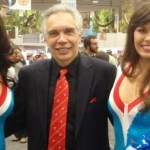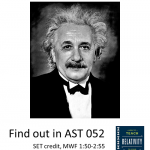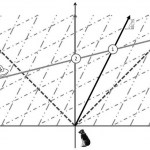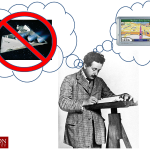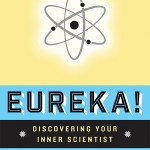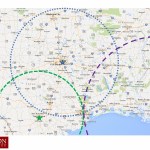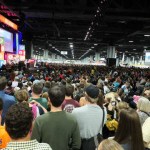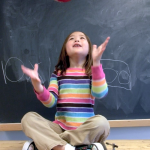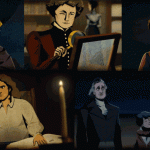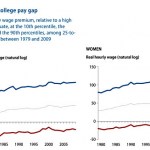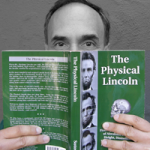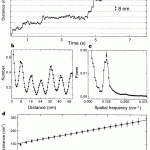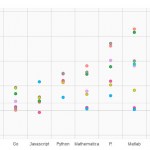Science
Guest Blog by Festival X-STEM Speaker Dr. Joe Schwarcz
How do you inspire students toward careers in science, and combat scientific illiteracy at the same time?
First, you spend two years planning the USA Science & Engineering Festival, the largest of its kind in the world. Then you rent the gigantic Washington Convention Center to host it and line up 3,000 displays, many of which feature hands-on activities.
You organize more than 150 stage presentations by Nobel laureates, athletes, astronauts, engineers and scientists of all kinds. You invite the likes of Bill Nye the Science…
This coming fall term, I'll be teaching Astronomy 052, "Relativity, Black Holes, and Quasars," because the guy who has traditionally taught it (a radio astronomer who studies active galactic nuclei) has to do other courses instead. But I said "Well, hell, I've written a popular audience book explaining relativity. I can teach that." And since I get to make teaching assignments (the one and only positive feature of being department chair), well, I put myself down to teach it. Now, of course, I find myself thinking about ideas for that class, months in advance, when I ought to be working on…
I've seen a few links passed around to this Tom Siegfried post about science literacy, which is mostly a familiar story about how polls show most Americans giving incorrect answers to science questions. The sort of stuff you find in the NSF's Science and Engineering Indicators report. What's getting the social-media attention, though, is this paragraph near the end:
In fact, I’d contend (and have contended) that the problem with science education is not that it fails to inculcate enough facts, but that it tries to inculcate too many. Science classes in high school and intro classes in…
We had a couple of weeks of unplanned hiatus due to sick kids and day care closures, so the superstitious among you might've thought we would never get to the 13th episode of Encertain Dots. Rhett and I are scientists, though, so we powered through:
Given the time of year, this is mostly about end-of-academic-year stuff: exams, intro course curricula, and undergrad research. The undergraduate research symposium I mention a few times is the Steinmetz Symposium, a Union tradition that will happen for the 24th time this Friday. This cancels a day of classes, which is a little annoying, but it's…
Last week's talks were using sci-fi space travel as a hook to talk about relativity, and my original idea for the talk was to explain how faster-than-light travel ultimately ends up violating causality. Some observers will see effects happening before the events that cause them, and that's just weird. In How to Teach Relativity to Your Dog, the illustration I use is a stationary dog watching a cat moving by at half the speed of light and a space alien zipping past at four times the speed of light. In that scenario, the dog can hand a water balloon to the passing alien to soak the cat, and…
I have a couple of things in the mental queue for this week, but I'm still playing catch-up from my trip to Texas, so instead you get a really quick comment on last night's Cosmos. This one was all about the history of the Earth-- continents moving, climate changing, mass extinctions-- stuff that I know in outline, but not detail. It was, by and large, far enough from my areas of expertise that I can't say much.
I did think that some parts of it were a little too pat, though. These fall into two categories: just-so stories, and things obvious in hindsight. The former includes the very…
Below you'll find the slides from my Physics Day presentations at Space Center Houston, embedded via SlideShare. I was doing the TED-style minimal text thing, so they're probably not all that comprehensible on their own.
The event was supposed to have a pop-culture connection, so I decided to use space travel and extrasolar planets as a hook for talking about relativity, thus all the movie images near the beginning. The original idea I had was to look at different fictional ways of evading the ban on faster-than-light travel, but they wanted something more in the half-hour range than the hour…
My Thursday presentation here in Houston went well, though it was a pretty small crowd. I'll be doing it again today before running to the airport to get home. I didn't really have an opportunity to do shameless self-promotion regarding the new book, but I did get a copy of the official cover for it, which you'll see above if you're looking at this on the blog, or below if you're reading via RSS.
I don't have a very detailed schedule for the rest of the process, but the target on-sale date is in early January 2015. Which probably dashes my dream of getting on the Colbert Report, but I'll…
One of the pop-physics books I've read recently was Amanda Gefter's much-discussed Trespassing on Einstein's Lawn. I was going to post a review of it back in March, but literally the day I was planning to write it, I got email from an editor at Physics Today asking if I had any books I'd like to review for them. So it ended up there instead of here:
Amanda Gefter’s Trespassing on Einstein’s Lawn comes with a super-sized subtitle: “A Father, a Daughter, the Meaning of Nothing, and the Beginning of Everything.” It’s a mouthful, but also rather fitting for a book that manages to be many things…
I had hoped to have another post or two scheduled for the end of this week, but The Pip got some kind of stomach bug, and threw everything into disarray. And tonight, I'm flying to Houston to give a couple of talks as part of Physics Day at Space Center Houston. Life being what it is these days, I'm still fiddling with the talk, so I don't have time to get any more big blog posts done.
If you're in the Houston area and free in the middle of the day Thursday or Friday, come by the Space Center-- I'm talking at noon both days. If you're not in Houston, or not free at lunchtime, well, I'll…
It is difficult to grasp the magnitude of what was accomplished not only this past weekend, but also the entire two years leading up to the 3rd USA Science & Engineering Festival. The official numbers from the Washington D.C. Convention Center reveal that over 325,000 attendees visited our Nation's Capital to partake in the largest celebration of STEM or as we have dubbed it- the Superbowl of STEM! In addition to our Expo Finale weekend, we reached over 180,000 students and teachers with our STEM initiative programs including our Nifty Fifty and X-STEM School Programs.
Numbers of…
Before going to the playground Saturday to investigate non-intertial frames, SteelyKid and I went over to campus to do some experiments in relativity. Galileian relativity, that is:
What you see here is SteelyKid sitting on a rolling lab cart with a camera bolted to it. She throws a ball up in the air a couple of times with the cart at rest, then I start pushing it across the room, and she tosses the ball a few more times. You can see from the video that, other than the motion of the background, the two cases look very similar.
This is a demonstration of the principle of relativity, which…
The Schenectady JCC, where SteelyKid and The Pip go to day care, has a playground with a merry-go-round on it. How this hasn't been sued out of existence, I have no idea, but it's a great boon to a physics professor. I've used it before to talk about angular momentum, but this weekend I enlisted SteelyKid's help to make a video illustrating a different sort of physics with the merry-go-round, a camera, and a tennis ball:
As you can see in the video, when the merry-go-round isn't moving, the ball rolls straight, but when it's spinning, the ball follows a curved path. This is a striking…
Back when the first episode of the Cosmos reboot aired, somebody put together a composite of the cartoon people who flashed on screen, and we played a guessing game on Twitter. The image above is from a blog post by Meg at True Anomalies, and I think it was probably her, but the ephemeral nature of Twitter makes it annoying to track down the original discussion.
Anyway, we collectively got four of the five right: ibn al-Haytham in the upper left, Annie Jump Cannon in the middle top, Isaac Newton on the lower left, and William Herschel on the lower right. Well, five of six, if you include…
While I'm complaining about statisticulation in social media, I was puzzled by the graph in Kevin Drum's recent post about college wage gaps, which is reproduced as the "featured image" above, and also copied below for those reading via RSS. I don't dispute the general phenomenon this is describing-- that the top 10% of college grads earn way more than the average, and the bottom 10% way less, and somewhat less than high school grads-- but I'm baffled about what was done to generate this graph.
Specifically, I'm puzzled by the vertical axis, which is labeled "Real hourly wage (natural log)."…
The finalists for the 2014 "Flame Challenge" have been selected, three written entries and three visual entries. None of these is my entry, alas, but it was worth a shot.
I watched the videos last night, and it was sort of interesting to compare what ended up working well with the test audience of 11-year-olds to the comments that I got. The main difference between what I did and what got picked wasn't so much in the use of unfamiliar words (the thing that generated comments on my post), but in the use of 11-year-old humor. (To be honest, I kind of hate one of them, because it overdoes the…
"The wonderful thing about Tiggers
Is Tiggers are wonderful things..."
Tigger was my favourite on the Hundred Acre Campus.
"...bouncy, trouncy, flouncy, pouncy
Fun, fun, fun, fun, FUN!"
Recently I was at a meeting, and a comment was made about how someone was being negative.
Not only was this a bit of a bummer, total downer, harshing everyone's mellow.
It actually violated our Code of Mututal Respect and Cooperation!
Namely Article 9: "Have a positive attitude"
Huh?
Well. Yes, I knew we had a Code. But I had not internalised this particular requirement, and the more I thought about it the…
Guest blog by Dr. John Sotos
Getting the Science Right in Hollywood Panel Member and Book Fair Author at the USA Science & Engineering Festival
I love medicine. But maybe not for the reasons you think.
Most people go into the field desiring to help others. Not me, at least not at first.
Many people go into medicine to make scientific discoveries. Not me.
And, alas, some people go into medicine to gratify their ego, pad their wallet, or satisfy parental expectations. Not me, thank goodness. I went into medicine because, well . . . I don't…
Recently, Carl Zimmer made a criticism of the computer animations of molecular events (it's the same criticism I made 8 years ago): they're beautiful and they're informative, but they leave out the critical aspect of stochastic behavior that is important in understanding the biochemistry. He's talking specifically about kinesin, a transport protein which the animators are particularly fond of illustrating.
Every now and then, a tiny molecule loaded with fuel binds to one of the kinesin "feet." It delivers a jolt of energy, causing that foot to leap off the molecular cable and flail wildly,…
Julia is a nifty new language being developed at MIT
I stole this plot from github, it shows Julia's current performance on some standard benchmarks compared to a number of favourite tools like Python, Java and R. Normalized to optimized C code.
And, there, in a single plot, is why Real Programmers still use Fortran...!
